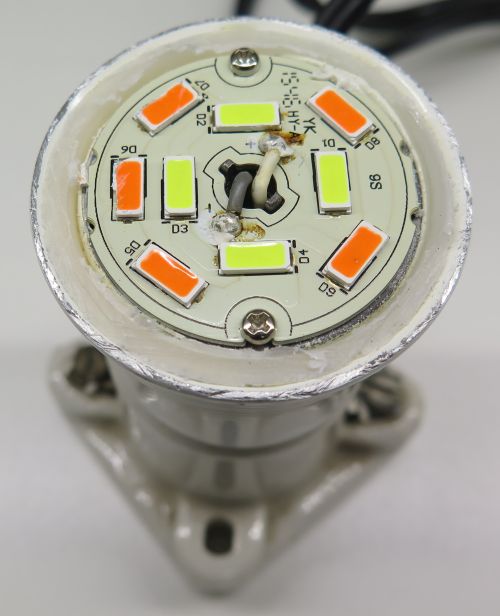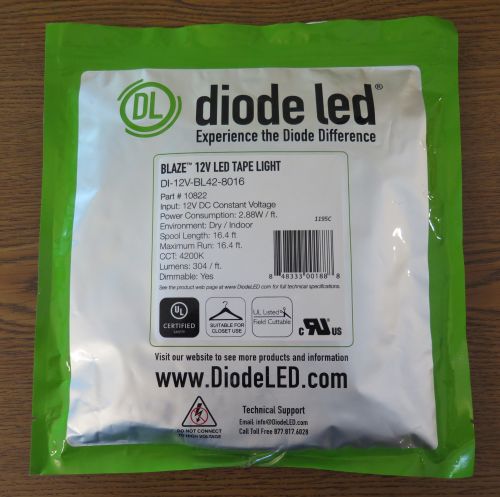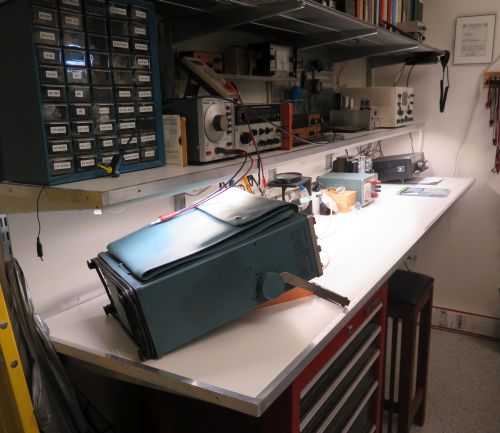
We replaced nearly all of the incadescent bulbs in the house with LED bulbs shortly after we bought it in late summer 2015. That came to 27 60W bulbs and ten or twelve 75W floods for ceiling can lights. You can’t get incandescent bulbs in the commoner sizes anymore, and the power savings is considerable. LED bulbs have come a long way in the last few years, and the “softer” light quality levels (3000K and below, most of which were 2700K for us) approximate incandescent light close enough for what we do.
There are a couple of issues with LED bulbs. We bought Feit bulbs in bulk when we re-bulbed all the ceiling fan lights. Two years on, and the Feit bulbs are dropping like flies. I have nine dead but intact Feit 60-watters on my workbench, and two more that I dismantled to see what’s in them. What’s in them isn’t much: A voltage doubler/rectifier board that converts 117VAC to 236 VDC. There’s a disk holding nine LEDs, with two wires down to the power supply. The photo above shows what it looks like when you hacksaw the plastic globe off a Feit 60W equivalent LED bulb. It’s unclear to me whether the nine LEDs are single diodes or blocks of several fabricated together. It seems like a stretch to put 26 volts on a single LED and not see it emit plastic instead of light.
I’ve been taking bulbs apart to try and see why the Feit bulbs die so young. I’ve pulled two apart: One had a bad power supply. The other had a bad wafer. The wafer, however, was intermittent: Tap it with a screwdriver and it flickers, and sometimes comes up to full brightness. The dead power supply was just dead, without any indication of why. It stayed dead when tapped, unlike the intermittent wafer. Cheap crappy manufacturing, I’d guess. This is one Feit I will gladly walk away from.
LED lighting is problematic in ham radio work because of the broadband noise generated by the bulb power supplies. Fluorescent tubes have the same general problem. My notion is to create a separate lighting system in my workshop/ham station using LED lamps run straight-on at 12VDC. I had hoped that the wafers ran at 12VDC or 24VDC, so that I could harvest them from bulbs with failed power supplies. Not an option.
So I started sniffing around to see what sort of lamps are available for 12VDC. I bought a couple at a hamfest to play around with, and talked to the techs at a lighting store up in Kierland. They had an interesting display: Assemble-it-yourself LED strip lights. These consist of an anodized aluminum U-channel, with a self-adhesive strip of LEDs stuck to the bottom of the channel, with a linear plastic lens that snaps into the U-channel. The LED strips take 12VDC, and use 2.88W per foot.

The LED tape strips come on a reel, with 16.4 feet on the reel and 3 LEDs per inch. The reel isn’t cheap; I paid $235 for it, and that’s about what they go for on Amazon. What I did was buy an 8′ section of channel/lens and put down just under 8′ of LED strip. The strips have clearly marked points every inch where you can cut them with an ordinary scissors, leaving solder pads on each side of the cut.

The strip comes with a .215″ female barrel connector on the end of 6′ of 2-conductor cord. But again, there are solder pads every inch, so you can wire them to a power source any way you want to. What I did (at least for testing) is dig around in my Big Box o’ Wall Warts and found a Dell APAC-1 power supply, which came with a Dell matrix printer someone gave me ten or twelve years ago. It’s labeled for 12VDC @ 2A, and the strip draws 1.92A, so the supply is working pretty hard. (It squeals, way up there where Carol can hear it and I can’t.)
What I did with the strip is mount the four clips that came with the U-channel under the front edge of the first shelf above my workbench, and then clipped the U-channel to the shelf. The lower surface of the shelf is 11″ above the bench, so I’d have to do some bending and stooping to actually see the LEDs. And the intensity of the light is marvelous, shining down right where I do the sort of close work that electronics requires, which these days is real damned close.

Because the light comes from a strip of 288 LEDs, there are basically no shadows anywhere under the strip, unless you completely block the light. This means that you can work in good light without worrying as much about your hands casting shadows on what you’re doing. It’s almost like the project photos in old QSTs, where all parts of a complicated hand-wired chassis are completely illuminated. The photo below is of a high-voltage power supply placed on the bench beneath the LED strip, and is literally what you’d see were you sitting at the bench poking at the supply.

This was only a first step. The strip won’t be powered by the APAC-1 long-term. I have a 30A 12VDC supply that I built out of an old minicomputer power supply somebody gave me. That will be the power source for all the lighting in my workshop/shack once the whole system is complete. I’m looking into overhead lighting now, and may simply use the remaining 8′ of LED strip on the reel with a white diffuser lens, clipped to the drywall ceiling.
Ultimately I want to work up a solar panel system on the roof of the garage, charging a 12V battery of some sort to supply lights and radios. The landscapers are going to auger a hole next to the shack for an engineered ground system tomorrow morning, so I have other work to do before I get on the air. It was a fun project, and will make working on projects a great deal easier. Good light is not optional!











5M for $235??? That’s WAY too expensive. You can get a 5M roll for $15 — https://www.banggood.com/Wholesale-300-LED-Super-Bright-5050-SMD-Waterproof-White-FlexibleStrip-5M-12V–p-41126.html
I just installed some RGB strips lights as under-cabinet kitchen lights for a friend, uses a WiFi controller that’s driven from a phone app or via an Alexa skill, so you can say “Alexa, kitchen lights 100%”. LEDs, controller, cables, PS brick, and aluminum channel/diffusers came to $50.
Well. I got took on that one bigtime. I wanted to buy locally because I wasn’t familiar with the technology and wanted to be able to talk to their techs if things didn’t work out, and that was the brand they carried. Now that I have a sense for it, I suspect I’ll shop more carefully. There are 5M reels for as little as $8, but they don’t review all that well. This is a good example:
https://www.amazon.com/HitLights-Warm-White-Light-Strip/dp/B005GL5UG2/
Judging by the reviews, the self-adhesive strip doesn’t stick well on these, which pretty much renders the product useless. I see a number of other SKUs on Amazon that review a great deal better in the $18-$24 range, and I think the price differential may be due to the “cheap China” effect. Much more to be done in the shop, and I’ll report back as I complete various stages of the project.
I’ve had good luck so far (limited testing) so I can’t speak to life-time on this stuff from CN. In my application, I used the aluminum channel with diffuser to hold the strips in place. Even before removing the adhesive backing on the strips, testing placement by snapping in the diffuser kept the strips in there pretty nicely, so if the adhesive fails, the strips aren’t going anywhere.
Here’s a short parts list on what I ordered for my project.
https://markdownshare.com/view/28bba84f-aa74-4c9d-9b86-39797e65c841
I’m planning to do an strip installation like you did (bright white) for above my lathe.
Another task lighting option is these COB (chip on board) LED strips. I bought 4 of these for that lathe light project I mentioned (still to be done). They are surprisingly bright when driven hard (and probably need a good heatsink).
https://www.ebay.com/itm/DC-12-14V-5W-170mmx15mm-COB-LED-Strip-Light-Super-Bright-Lamp-Chip-Cool-White-/232305460998?hash=item36167c0706
Agreed on the glue. Use zip ties or your own adhesive. I prefer zip ties so I can take the thing down and fix/replace any bad parts.
“Well. I got took on that one bigtime.” Not necessarily. If you were willing to pay the price, and it works well, and lasts, you got your money’s worth.
I have *many* things that I paid a lot for; my H-P calculator, my Fluke DMM, my Tektronix ‘scope. Yes, I could have gotten something else for a lot less. But they were great products, they still work, and I still use them regularly.
Don’t fall for the mind-trap that nothing matters except price. Buying it only encourages things to get worse. There’s a reason that all that cheap crap winds up in the closet or as e-waste so quickly.
Those LED strips look kind of like the multicolor LED strips that I used to make the Amelia Storm CyberDress. (Details here). The NeoPixel strips run on 5V, however, and are individually addressable through a serial data line to set each one to a unique RGB color. I used six of them, sewn to the lining of the skirt yet visible through the sheer overlayer. They’re all hooked to a Flora microcontroller board (an Arduino) that drives them in programmed patterns, with a control button mounted to my wrist that allows the light program to be changed as I perform. Because of power supply limitations (3xAAA batteries for the entire system), my light programs can’t light more than about 40 of the LEDs at once, but that still allows for some pretty spectacular light effects.
Search for “USB battery charger” on eBay. They’re fancy flat lithium-ion batteries with a USB connector. You charge them via USB, and then you’re supposed to plug them into your phone or other USB device to recharge that.
I’m guessing they’re intended for backpackers or campers or something, but they hold a lot of power in a small, flat, lightweight package.
I have one of these – with the right circuitry they could jump-start a car, I suspect – and mine works extremely well. There are models that weigh less but are of lower capacity, but consider that the best AAAs are about 5% of the capacity of this beast, there’s plenty of leeway.
https://smile.amazon.com/gp/product/B00X5RV14Y/ref=oh_aui_search_detailpage?ie=UTF8&psc=1
The thing I’d worry about is how heavy the battery charger is and how easy it’d be to mount. Right now, I have the battery pack mounted to the dress lining with a small elastic loop, that I can remove easily to change out the batteries. The battery pack also has a convenient power switch on it, so I can keep the dress powered off until just before I go on stage.
I’d probably also have to rewire the power supply lines to the NeoPixel strips, to drive directly off the battery instead of going through the Flora’s voltage regulators.
There’s a review of these on Kevin Kelly’s CoolTools blog:
http://kk.org/cooltools/waterproof-rgb-led-strip/
I just bought a dozen 4′ 2700K lights for my workshop. The old-school LED lights always looked blue to me; these, and the handful og 2700K bulbs I’ve put in the house, are okay.
We used a lot of the “curly CFL” bulbs in the house, but I was never too happy with their failure mode, which typically involved bad smells and trails of smoke. It didn’t matter whether they have some US name brand on them or were Harbor Freight cheapies. They probably came off the same production line anyway.